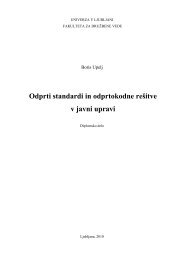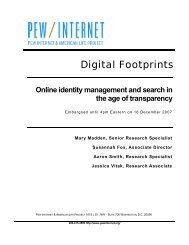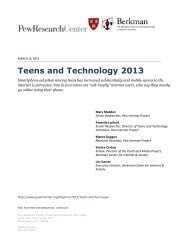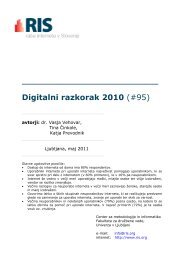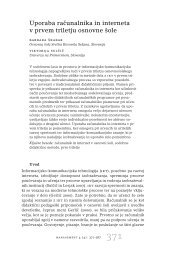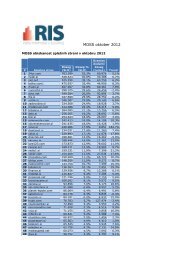the Labour Market Survey Report - Council of European ...
the Labour Market Survey Report - Council of European ...
the Labour Market Survey Report - Council of European ...
You also want an ePaper? Increase the reach of your titles
YUMPU automatically turns print PDFs into web optimized ePapers that Google loves.
Annex A<br />
Definitions, Datastructures and Limitations<br />
Definitions: What are IT Practitioners and where do <strong>the</strong>y work?<br />
There are probably as many views as to what IT Practitioners are and do as <strong>the</strong>re are people who take an<br />
interest in this area. It is inevitable that readers <strong>of</strong> this report from different EU Member States will have<br />
a range <strong>of</strong> particular perspectives. The different kind <strong>of</strong> work in (and around) labour markets, including<br />
<strong>the</strong> work <strong>of</strong> those considering and developing:<br />
• careers material,<br />
• education and training approaches and programmes,<br />
• pr<strong>of</strong>essional formation and career development requirements, and<br />
• salary surveys,<br />
all require <strong>the</strong> assumption <strong>of</strong> a set <strong>of</strong> occupational definitions (with a greater or lesser detail <strong>of</strong><br />
skill/competence requirements) in <strong>the</strong> broad area <strong>of</strong> interest. These different focuses inevitably have<br />
different requirements as to <strong>the</strong> amount <strong>of</strong> detail <strong>of</strong> skill requirements and <strong>the</strong> “granularity” <strong>of</strong> <strong>the</strong><br />
classification. For example, Salary surveys generally require information about a comparatively large<br />
number <strong>of</strong> occupational categories, so that individual employers will learn about market conditions for<br />
<strong>the</strong> categories <strong>the</strong>y happen to use – this can result in many dozens <strong>of</strong> “job titles” being used for different<br />
kinds <strong>of</strong> IT practitioners. On <strong>the</strong> o<strong>the</strong>r hand, careers material needs to paint a “broad brush” picture <strong>of</strong><br />
general areas <strong>of</strong> activity in an attractive way – here <strong>the</strong> number <strong>of</strong> types <strong>of</strong> IT practitioner would generally<br />
be much lower – generally less than 10.<br />
In addition to <strong>the</strong> range <strong>of</strong> application areas for occupational classifications, <strong>the</strong> speed <strong>of</strong> development<br />
<strong>of</strong> <strong>the</strong> technology, <strong>of</strong> <strong>the</strong> tools, systems and methodologies arising from this and <strong>the</strong>ir penetration into<br />
<strong>the</strong> marketplace have also played a role. As IT management and occupational analysts in different<br />
organizations, contexts and countries have tried – over <strong>the</strong> last few decades - to distil structure from<br />
<strong>the</strong> fast-changing picture, it is understandable that a number <strong>of</strong> different occupational frameworks have<br />
emerged.<br />
But from <strong>the</strong> point <strong>of</strong> view <strong>of</strong> sound analysis <strong>of</strong> <strong>the</strong> IT Practitioner labour market – <strong>of</strong> tracking<br />
developments and understanding <strong>the</strong> labour market well enough that sensible decisions can be made,<br />
both at <strong>the</strong> enterprise and at <strong>the</strong> public policy levels – <strong>the</strong> most important set <strong>of</strong> occupational frameworks<br />
are those for which surveys (whe<strong>the</strong>r <strong>of</strong> employers or <strong>of</strong> individuals) have been carried out. Even<br />
within a single country (e.g. <strong>the</strong> United Kingdom) a range <strong>of</strong> different frameworks have been used for<br />
surveys (<strong>the</strong>se are shown in Skills99). While <strong>the</strong>re are broad similarities, <strong>the</strong> fact that <strong>the</strong> frameworks<br />
used are not <strong>the</strong> same means that data ga<strong>the</strong>red from <strong>the</strong> different surveys cannot generally be usefully<br />
compared, and thus contribute to building up an overall picture enriched by evidence from all <strong>the</strong><br />
different surveys.<br />
The great desirability <strong>of</strong> <strong>the</strong> use <strong>of</strong> a single (“unifying”) framework for all surveys (and ideally, for as many<br />
o<strong>the</strong>r applications as possible) led to an initiative over <strong>the</strong> late 1990s within <strong>the</strong> UK to win wide support<br />
for such a framework, built largely from <strong>the</strong> BCS’s Industry Structure Model. The resulting framework<br />
94<br />
| C E P I S I.T. PRACTITIONER SKILLS IN EUROPE | Annex A



